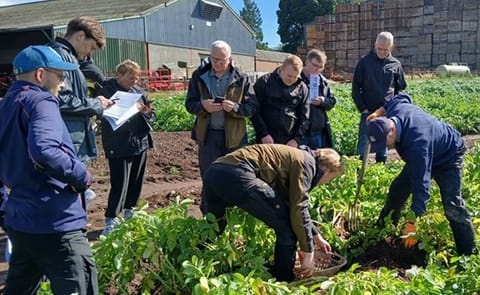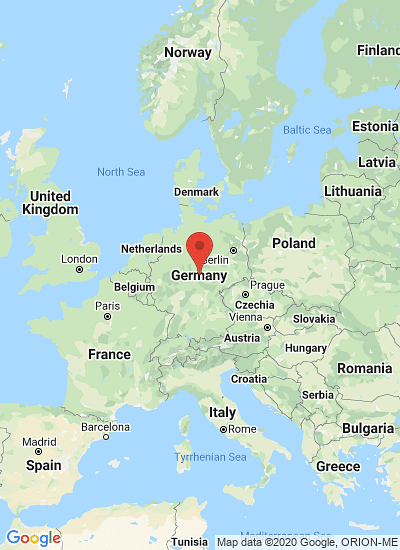Dr. Christian Göke , CEO of Messe Berlin GmbH, commented: “FRUIT LOGISTICA is one of a kind"
Fruit Logistica 2014 open for business

More than 58,000 high-ranking trade visitors from over 120 countries gathered in the exhibition halls can mean only one thing: it’s time for FRUIT LOGISTICA, the leading trade fair for the international fresh produce industry.
From 5 to 7 February 2014, more than 2,600 exhibitors from 84 countries will be presenting the entire product and service range from all levels of the fresh produce trade. They will also be displaying numerous industry innovations that serve as a valuable driving force in the industry and increase the variety of options for the consumer. 90% of the exhibitors and around 80% of the trade visitors will be coming from outside Germany, making FRUIT LOGISTICA one of the most international trade fairs worldwide.
Dr. Christian Göke , CEO of Messe Berlin GmbH, commented: “FRUIT LOGISTICA is one of a kind. It covers all business areas and market players around the world and offers excellent opportunities to establish contact with key decision-makers, and has a truly impressive international scope. Nowhere is the innovative strength of the fresh produce trade more palpable than at FRUIT LOGISTICA. As the industry’s platform for innovation we have launched a new series of events that gives trade visitors a glimpse of the future. The ‘Future Lab’ showcases innovative projects that will enhance the fruit and vegetable industry with innovations in the coming years or contribute significantly to optimisation along the value chain.”
Argentina: Official partner country of Fruit Logistica 2014
Argentina is the official partner country of FRUIT LOGISTICA 2014. One of the biggest producers of fresh fruit and vegetables in the southern hemisphere, Argentina exports a wide range of products to more than 100 countries. The country’s export earnings increased to USD 1.7 billion in recent years.
This figure highlights Argentina’s growing importance as a producer and export country for the international fresh produce trade. Argentina currently exports more than 1.9 million tonnes of fruit and vegetables each year. As general prosperity has increased throughout Latin America, the industry has enjoyed an annual growth rate of 11.2% within the last ten years. Europe remains the country’s most important trading partner with a share of 32% of exports, followed by Brazil (28%), Russia (11%) and the USA (7%).
Argentina exports a wide range of products. Highlights include pomaceous fruit (apples, grapes and pears – Argentina is the world’s biggest exporter of the latter), citrus fruit (lemons, mandarins, oranges, grapefruit), stone fruit (cherries, plums, peaches) and berries (blueberries, strawberries). It also enjoys international renown for its garlic, onions, pumpkins, olives, potatoes and tomatoes.

Argentina is partner country of Fruit Logistica 2014
Argentina has exhibited at FRUIT LOGISTICA every year since 2000. The Argentinean pavilion is organised by the FundaciónExportAr and the CFI (Consejo Federal de Inversiones) and brings together more than 50 exporters in 840m2 of exhibition space.
Global fresh produce sector facts and figures
According to the latest figures from the AMI (Agricultural Market Information service) in Bonn, some 950 million tonnes of vegetables (excluding melons) and 790 million tonnes of fruit (including melons) were produced worldwide in 2013. Production figures for both fruit and vegetables have steadily increased in recent years.
Compared to the poorer harvest of the previous year, the EU fruit crop increased by almost 7% in 2013 (that is, 2013/14) to around 37 million tonnes. With approximately 63 million tonnes, the EU vegetable harvest in 2013 is likewise expected to show an increase of almost 2% compared to the previous year.
Following what was already a smaller harvest in 2012, the volume of commercially cultivated fruit in Germany in 2013 dropped again to just over 1.1 million tonnes (–13%). The long winter, a very wet May and a late but hot and dry summer made for poor conditions for high yields. Apples, the most important crop, were down to 800,000 tonnes, a decrease of more than 17% compared to the previous year.
Having declined in the two previous years, German imports of fresh vegetables for 2013 reached almost 3.1 million tonnes, according to an estimate by the AMI. Spain’s market share increased a little, while Italy’s was somewhat down. The market share of the EU’s other fresh vegetable suppliers remained more or less stable. The Netherlands and Spain are the most important supplier countries; followed by some distance France and Belgium. Imports of fresh vegetables from non-EU countries are minimal.
German imports of fresh fruit (including tropical fruits) have increased again in 2013 after falling for several years, probably putting them just past the 5 million tonne mark again. Spain is also one of the leaders here. Other countries play a much larger role here with 44% of German fruit imports coming from non-EU countries.
Average private household purchased 156 kg of fresh fruit and vegetables
With an average of 86.7 kg per household in 2013, German private households purchased nearly 1% less fresh fruit than in the previous year, but spent at least 6% more on it. Apples, bananas and oranges are the fruit that German consumers purchase in the largest quantities. Sales of apples were down in 2013, with bananas and oranges on the rise. The fall in apple purchases was largely a result of poorer harvests and chiefly affected the second half of the 2012/13 season. Since the beginning of the 2013/14 season there has been only a very slight downward trend. Other fresh fruit varieties topping the list for increased sales were table grapes and melons, while easy peelers, nectarines and pineapples all suffered losses.
Fresh vegetables ( 69.3 kg per household) showed a slight decline in sales, although the decrease likewise only amounted to just over 1%. Consumer spending for fresh vegetables increased by a good 4%. Tomatoes, carrots and onions are the most significant products by purchase volume. Sales of cauliflower, leeks and onions were down from the previous year, while courgettes and iceberg lettuce were purchased in larger quantities. Purchase volumes of the major fruit vegetable varieties such as tomatoes, cucumbers and sweet peppers also increased slightly.
The top ten favourite fruits and vegetables
In terms of fresh fruit, private households consumed the following on average in 2013: 18.7 kg of apples, 15.6 kg of bananas, 10.3 kg of oranges, 6.4 kg of easy peelers, 5.3 kg of grapes, 4.6 kg of melons, 4.4 kg of strawberries, 3.1 kg of nectarines, 2.9 kg of pears and 2.1 kg of pineapples.
On average, private households bought the following amounts of fresh vegetables in 2013: 11.4 kg of tomatoes, 8.4 kg of carrots, 7.5 kg of onions, 7.2 kg of cucumbers, 5.7 kg of sweet peppers, 3.1 kg of iceberg lettuce, 2.2 kg of asparagus, 2.0 kg of cauliflower, 1.5 kg of leeks and 1.5 kg of courgettes.
Leading the way: Organic and Fresh Convenience Routes
Organic and fresh convenience products offer strong opportunities for sales growth and feature prominently at FRUIT LOGISTICA. The Organic and Fresh Convenience Routes have been especially created to help trade visitors quickly and easily find suppliers of organic and fresh convenience products from among the more than 2,600 exhibitors represented at the trade fair. These online tools allow trade visitors to quickly identify all exhibitors in these segments in the Virtual Market Place.








